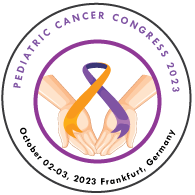Nourhan Abdalkader
School of Pharmacy, Newgiza University, Cairo, Egypt
Title: Measuring the prevalence of fatigue in children with cancer: Evidence from Egypt.
Biography
Biography: Nourhan Abdalkader
Abstract
Background: Cancer related fatigue (CRF) is a common side effect of cancer and cancer treatment that impacts every aspect of quality of life. To our knowledge, the statistics for prevalence in pediatrics are lacking in Egypt. The aim of this study is to record the prevalence of fatigue and its significant predicting factors in pediatric oncology patients.
Methods: we interviewed children aged 8-18 years with cancer, prescribed chemotherapy and not in severe distress. After the consent of the guardian is taken, the children personally filled 2 fatigue-related questionnaires (PROMIS Pediatric Short Forms of Fatigue (PROMIS fatigue), pedsQL multidimensional fatigue (PedsQL fatigue)) and 3 symptoms related questionnaires.
Results: 42 children (47.6% female) (mean age 12.1 years (SD 3.3 years)) participated. Half of the children were in primary school (n=21, 50%) and most of them had their parents accompanying them (n=35, 83.3%). Most children suffered from a hematological tumor (n=35, 83.3%) and didn’t suffer from other chronic health conditions (n=39, 92.8%). Reported moderate to severe fatigue in children is between half to third of the children depending on the measurement tool used. The mean T-score for PROMIS fatigue was 53.76 (SD 12.5), the mean score for PedsQL fatigue was 74.27 (SD 21.79). Stepwise standardized multivariant linear regression showed that fatigue following PROMIS fatigue could be predicted by depressive symptoms (ðœ·= 0.47, p <0.001) and mobility (ðœ·= -0.39, p =0.002) while following PedsQL fatigue, it could be predicted by upper extremity function (ðœ·= 0.34, p= 0.005), depressive symptoms (ðœ·=-0.49, p <0.001) and treatment status (ðœ·=-0.25, p= 0.013).
Conclusion: CRF is multifactorial and prevalent among children and adolescents with cancer. Moreover, predicting factors differed between different tools as they measure fatigue from different dimensions. PedsQL fatigue was predicted by more factors. There is a need to include fatigue screening for pediatric oncology patients and incorporate its management in the medical care plan.

